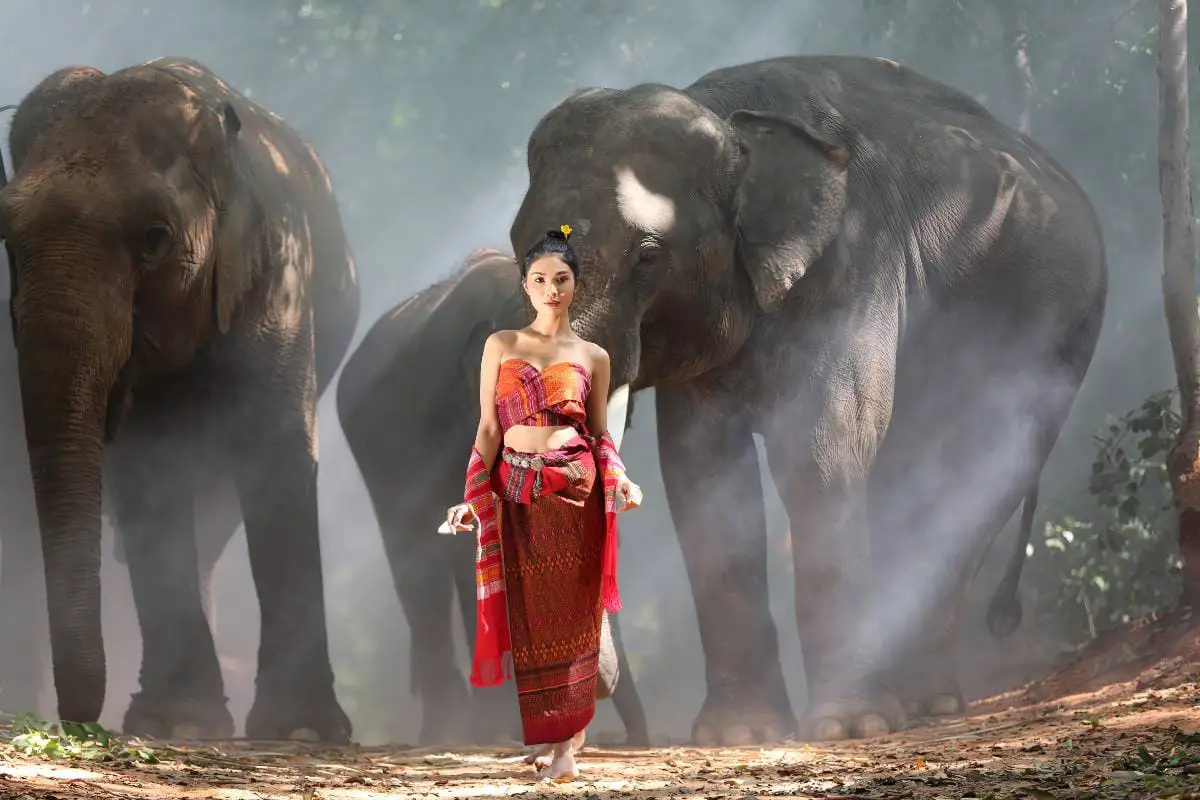Navigating Fashion in Thailand as an Expat
When I first landed in Bangkok five years ago, I quickly realized that my carefully packed suitcase of clothing was largely unsuitable for my new life. Coming from the seasonal changes of the United States, I found myself unprepared for Thailand’s distinct fashion landscape shaped by its tropical climate, cultural traditions, and evolving style scene. As an expat navigating Thai fashion, I’ve learned valuable lessons about dressing appropriately while maintaining my personal style.
Key Takeaways
- Natural fabrics like cotton, linen and Thai silk are essential for staying comfortable in Thailand’s tropical climate.
- Respect cultural dress codes by covering shoulders and knees when visiting temples or attending formal events.
- Tailor-made clothing offers exceptional value and better fit for Western frames than off-the-rack options.
Table of Contents
Understanding Thailand’s Fashion Context
Thailand’s fashion environment is a fascinating blend of traditional influences and contemporary global trends. In major urban centers like Bangkok, you’ll find everything from ultra-modern shopping malls showcasing international brands to vibrant street markets filled with local designs. The country’s fashion industry has grown significantly in recent years, with Thai designers gaining recognition on global runways.
My initial misconception was thinking that casual tropical wear would suffice everywhere. However, I soon discovered that Thai fashion sensibilities are more nuanced than I anticipated. Locals often dress quite formally for work and social occasions, with careful attention to appearance being highly valued in Thai culture.
Adapting to the Climate While Staying Stylish
The tropical climate in Thailand presents unique fashion challenges. With temperatures regularly exceeding 30°C (86°F) and humidity levels that can make it feel even hotter, breathability becomes your primary concern. During my first month, I made the mistake of wearing my favorite synthetic fabrics, only to find myself uncomfortably sweaty within minutes of stepping outside.
I’ve since learned to prioritize natural, lightweight materials like cotton, linen, and silk. These fabrics allow air circulation and wick moisture away from the body. Thai silk, in particular, has become a staple in my wardrobe—not only is it practical for the climate, but purchasing locally-made silk also supports traditional Thai craftsmanship.
Loose-fitting clothes that don’t cling to the body are ideal for hot weather, but this doesn’t mean sacrificing style. I’ve found that well-tailored linen shirts and pants can look professional while keeping you cool. Women expats often opt for flowing dresses and skirts that provide both comfort and elegance.
Navigating Cultural Dress Codes
Perhaps the most important lesson I’ve learned about fashion in Thailand is respecting cultural sensitivities regarding appropriate attire. While tourist areas and expat neighborhoods may be more relaxed, traditional Thai values still influence dress codes, especially when visiting temples, government offices, or formal events.
When entering temples or royal properties, shoulders and knees must be covered for both men and women. I always keep a lightweight scarf or sarong in my bag for impromptu temple visits. Business settings typically require conservative attire—for men, this means long trousers and collared shirts, while women are expected to dress modestly with covered shoulders and skirts or dresses that extend below the knee.
I’ve noticed that Thai people generally dress more formally than Westerners for everyday activities. Even in casual settings, locals rarely wear revealing clothes, and neat, clean presentation is highly valued. Adapting to these norms demonstrates respect for Thai culture and helps facilitate smoother integration into local communities.
Shopping for Fashion in Thailand
One delightful aspect of expatriate life in Thailand is discovering the diverse shopping options. Bangkok’s modern malls like Siam Paragon, CentralWorld, and EmQuartier offer international brands alongside established Thai designers. For more budget-friendly options, markets like Chatuchak Weekend Market and Pratunam Market provide endless varieties of clothing at negotiable prices.
I’ve found that custom tailoring offers exceptional value in Thailand. For the price of off-the-rack clothes in Western countries, you can have garments custom-made to your specifications. After several disappointing purchases that didn’t quite fit my Western frame, I discovered that having key wardrobe pieces tailor-made ensures better fit and longevity.
Online shopping has also expanded dramatically in Thailand, with platforms like Lazada, Shopee, and Instagram stores making fashion accessible even from the comfort of your air-conditioned home. Many smaller Thai designers maintain active social media presences, allowing you to discover unique pieces that aren’t available in physical stores.
Balancing Western Identity and Local Integration
Finding the right balance between maintaining your cultural identity and adapting to local norms is a common challenge for expats. I’ve settled on a wardrobe that respects Thai sensibilities while incorporating elements of my personal style. This approach has allowed me to feel comfortable and authentic while avoiding unintentional cultural faux pas.

For work environments, I maintain a more conservative appearance than I might have in the United States, but I express my personality through subtle accessories or fabric choices. In social settings with other expats, I might dress more casually, while gatherings with Thai colleagues or friends call for slightly more formal attire.
Many expats fall into the trap of dressing too casually, which can inadvertently create barriers to cultural integration. I’ve observed that making an effort with your appearance is often interpreted as showing respect for Thai culture and the people around you. This attention to appropriate dress has opened doors in both professional and social contexts that might otherwise have remained closed.
Seasonal Considerations
While Thailand doesn’t experience dramatic seasonal changes like those in temperate climates, there are subtle variations worth considering for your wardrobe. The hot season (March to June) demands the lightest, most breathable fabrics, while the rainy season (July to October) calls for quick-drying materials and appropriate footwear to navigate flooded streets.
Even during the “cool” season (November to February), temperatures rarely drop below 20°C (68°F) in central and southern Thailand, though northern regions like Chiang Mai can become quite cool in the evenings. A light jacket or cardigan is usually sufficient for these cooler periods. After experiencing my first “winter” in Bangkok without appropriate layers, I’ve learned to keep a few warmer items on hand for air-conditioned offices and occasional temperature drops.
Final Thoughts: Fashion as Cultural Dialogue
After years of living in Thailand, I’ve come to view fashion not just as practical necessity but as a form of cultural dialogue. My wardrobe choices communicate respect for Thai traditions while maintaining aspects of my Western identity. This balance has enriched my expatriate experience, helping me feel both comfortable and connected to my adopted home.
For new expats arriving in Thailand, I recommend observing local dress norms, investing in quality, climate-appropriate basics, and being willing to adapt your style while staying true to yourself. The effort you put into appropriate dress will be noticed and appreciated by Thai colleagues, friends, and acquaintances.
Fashion in Thailand offers expats a unique opportunity to blend practicality, cultural sensitivity, and personal expression. By approaching Thai fashion with openness and respect, you’ll not only look and feel better in the tropical climate but also demonstrate your commitment to understanding and honoring the culture of your host country.
BetterLivingAsia: Your Trusted Guide to Expat Life in Thailand
At BetterLivingAsia, we create helpful resources based on real experiences living abroad. Our content covers everything from fashion and cultural etiquette to housing, visas, and daily practicalities that make transitioning to Thai life smoother and more enjoyable. Founded by expats for expats, we understand the challenges you face and provide practical solutions to help you thrive in your new home.
FAQs
What should I wear in Thailand as an expat?
When planning a trip to Thailand, it’s important to wear clothing that is suitable for the hot and humid climate. Opt for lightweight and breathable fabrics like cotton or linen. Dresses, tank tops, and maxi dresses are great choices, but ensure they cover your shoulders and knees, especially when visiting temples in Thailand.
What are some packing tips for a trip to Thailand?
When you pack for Thailand, consider the weather and local customs. Bring a mix of casual and conservative attire, including long pants and a shawl for temple visits. Don’t forget comfortable sandals or breathable footwear, as you’ll likely be walking a lot.
Are there any specific attire guidelines for visiting temples in Thailand?
Yes, when visiting temples in Thailand, you must adhere to a strict dress code. Always wear clothing that covers your shoulders and knees. Avoid tank tops and shorts. A long-sleeved shirt and long pants or a long skirt are ideal. A shawl can be handy for covering your shoulders.
How do fashion trends in Thailand influence what I should wear?
Fashion trends in Thailand often blend traditional Thai clothing with international styles. While you can embrace Thai fashion by wearing a chut thai or other traditional attire, it’s also acceptable to wear international fashion. Just remember to keep it respectful and modest, especially in religious settings.
What types of shoes should I wear in Thailand?
Comfortable shoes to wear in Thailand are essential due to the hot climate and extensive walking. Sandals and breathable shoes are recommended. Avoid closed shoes that can make your feet too hot. Consider packing a pair of shoes that can easily be removed for temple visits.
Conclusion
If you’re considering relocating to Thailand or elsewhere in Asia, proper preparation extends far beyond just packing the right clothes. At BetterLivingAsia.com, we provide comprehensive resources to help you navigate every aspect of expatriate life. From visa requirements and housing options to cultural etiquette and lifestyle considerations, our team of experienced expats offers invaluable insights to make your transition smoother.
Contact us today to learn more about how we can support your journey to a better life in Asia. Our personalized consultation services will help you avoid common pitfalls and make informed decisions as you embark on this exciting new chapter.






